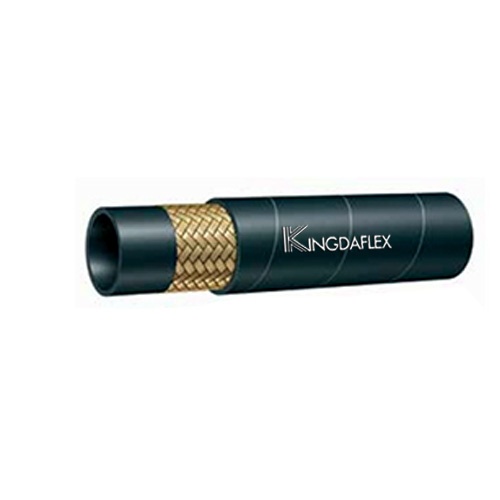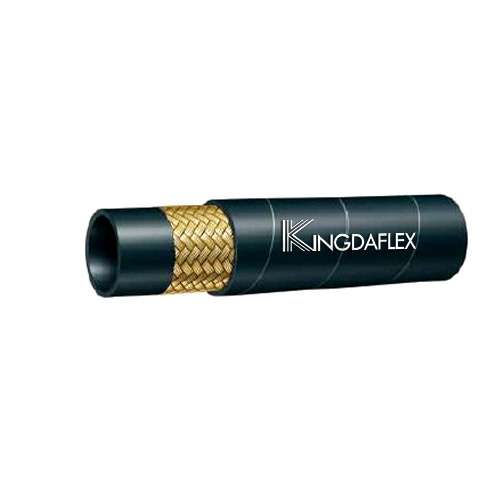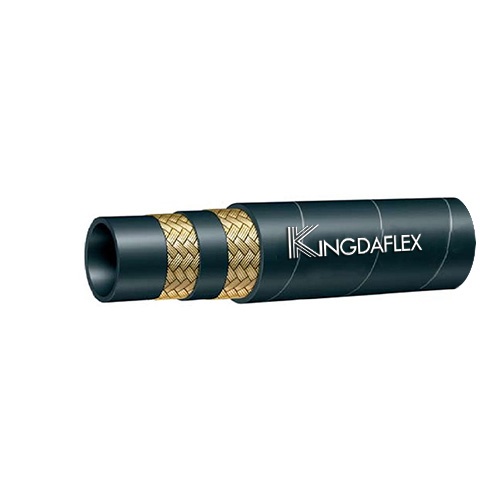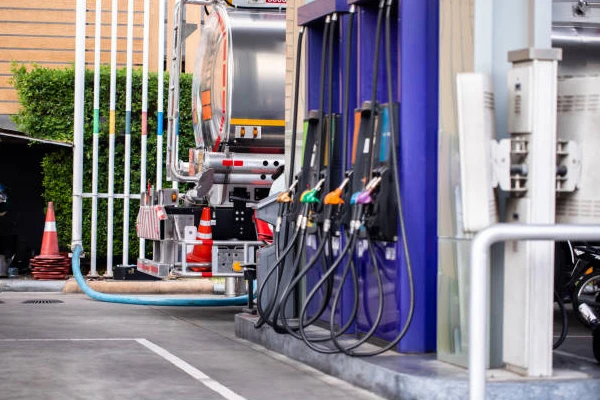When selecting hydraulic hoses, understanding the differences between R1 and R2 types is crucial for ensuring optimal system performance and safety. These designations indicate specific construction and pressure ratings, directly impacting their suitability for various applications. This guide will explore the key distinctions between R1 and R2 hydraulic hoses.
We’ll delve into their construction, pressure capabilities, and typical applications, providing you with the knowledge to make informed decisions for your hydraulic systems. By comparing these hose types, you’ll be able to choose the right hose to meet your specific operational needs and ensure long-term reliability.
What Is R1 Hydraulic Hose
R1 hydraulic hose is a type of medium-pressure hydraulic hose designed for general-purpose hydraulic applications.
It features a single wire braid reinforcement, which provides adequate strength and flexibility for moderate pressure systems. This construction makes it suitable for various applications where flexibility and cost-effectiveness are important, such as in agricultural equipment, construction machinery, and general industrial hydraulic systems.
What Is R2 Hydraulic Hose
R2 hydraulic hose is a high-pressure hydraulic hose designed for demanding applications requiring increased strength and durability.
It features a double wire braid reinforcement, which provides enhanced pressure resistance compared to R1 hoses. This robust construction makes it suitable for heavy-duty hydraulic systems in construction, mining, and industrial machinery, where high pressures and challenging operating conditions are common.
What Does “R” Mean in Hydraulic Hose
In the industry of hydraulic hoses, the “R” designation refers to the reinforcement type and construction of the hydraulic hose. It’s a key identifier that helps distinguish between different hose designs, particularly concerning the wire braid reinforcement layers.
This designation is commonly used in SAE (Society of Automotive Engineers) standards, which are widely recognized in the hydraulic industry. The “R” followed by a number, such as R1 or R2, indicates the specific type and number of wire braid layers used in the hose’s construction.
Specifically, the “R” classification helps users quickly understand the hydraulic hose’s pressure rating and suitability for various applications.
For example, R1 hoses typically feature a single wire braid reinforcement, while R2 hydraulic hoses have a double wire braid. This difference in construction directly impacts the hydraulic hose’s ability to withstand high pressures and its overall durability.
Therefore, the “R” designation is crucial for selecting the appropriate hydraulic hose for specific operational requirements, ensuring safety and efficiency in hydraulic systems.
Hydraulic Hose R1 vs R2
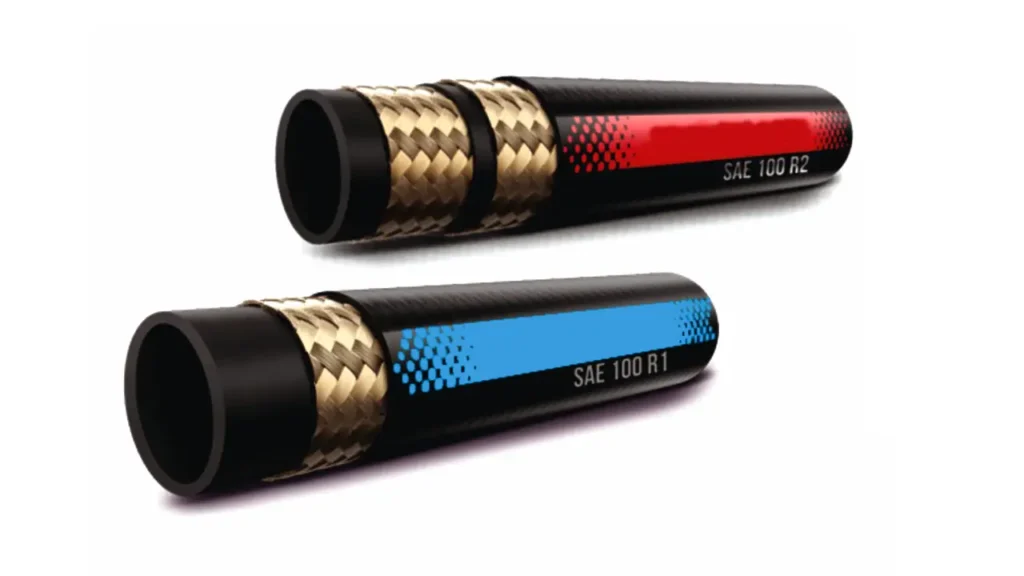
When selecting hydraulic hoses, understanding the differences between R1 and R2 types is crucial for ensuring optimal performance and safety. These hoses, while both designed for hydraulic systems, possess distinct characteristics that cater to varying pressure and application requirements.
We’ll delve into the key aspects that differentiate R1 and R2 hydraulic hoses, providing a comprehensive comparison to guide your selection process.
Hydraulic Hose Reinforcement Layers
R1 hydraulic hoses are constructed with a single layer of steel wire braid reinforcement. This design allows for adequate strength to handle medium-pressure applications while maintaining a high degree of flexibility. The single wire braid contributes to the hose’s ability to bend and flex easily, making it suitable for applications where routing flexibility is crucial. The inner tube and outer cover are typically made of synthetic rubber, providing good fluid compatibility and abrasion resistance.
R2 hydraulic hoses feature a double layer of steel wire braid reinforcement, significantly enhancing their pressure-bearing capabilities. This double layer provides superior strength and durability compared to R1 hoses, making them ideal for high-pressure applications. The robust construction enables R2 hoses to withstand demanding operating conditions and high impulse pressures. While they offer greater strength, the double reinforcement also reduces their flexibility compared to R1 hoses.
Hydraulic Hose Pressure Ratings
R1 hydraulic hoses are designed for medium-pressure applications, typically operating within a range of 1,500 to 3,000 PSI, depending on the hose size. This pressure rating makes them suitable for general-purpose applications in various industries, including agriculture, construction, and manufacturing. Their ability to handle moderate pressures while maintaining flexibility makes them a versatile choice for many hydraulic systems.
R2 hydraulic hoses are engineered for high-pressure applications, capable of handling pressures ranging from 3,000 to 6,000 PSI or even higher, depending on the specific hose size and construction. This high-pressure rating makes them essential for heavy-duty applications in industries like mining, heavy construction, and offshore drilling. Their robust construction and high-pressure capacity ensure reliable performance in demanding environments.
Hydraulic Hose Flexibility
R1 hydraulic hoses offer excellent flexibility due to their single wire braid reinforcement. This flexibility allows for easier routing and installation in complex hydraulic systems, especially where space is limited. The ability to bend and flex without kinking or collapsing makes R1 hoses a practical choice for applications requiring frequent hose movement or tight bends.
R2 hydraulic hoses, with their double wire braid reinforcement, are less flexible compared to R1 hoses. The additional reinforcement layers provide superior strength and pressure resistance but reduce the hose’s ability to bend and flex. This reduced flexibility makes R2 hoses more suitable for applications where high pressure and durability are paramount, even if it means sacrificing some flexibility in routing.
Hydraulic Hose Cost
R1 hydraulic hoses are generally more cost-effective than R2 hoses. The simpler construction and single wire braid reinforcement contribute to their lower price point. This cost advantage makes R1 hoses a budget-friendly option for general-purpose hydraulic applications where high pressure is not a primary concern.
R2 hydraulic hoses are more expensive due to their double wire braid reinforcement and higher pressure ratings. The enhanced performance and durability justify the higher cost, especially in demanding applications where reliability and longevity are crucial. While the initial investment is higher, the extended service life and reduced risk of failure can lead to long-term cost savings.
Hydraulic Hose Applications
R1 hydraulic hoses are commonly used in applications such as agricultural equipment, general construction machinery, and industrial hydraulic systems where moderate pressure and flexibility are essential. Their versatility makes them suitable for a wide range of general-purpose hydraulic tasks.
R2 hydraulic hoses are primarily used in heavy-duty applications such as mining equipment, heavy construction machinery, and offshore drilling operations. Their robust construction and high-pressure ratings make them indispensable in environments where extreme conditions and high pressures are prevalent.
| Feature | R1 Hydraulic Hose | R2 Hydraulic Hose |
| Reinforcement | Single Wire Braid | Double Wire Braid |
| Pressure Rating | Medium (1,500 – 3,000 PSI) | High (3,000 – 6,000+ PSI) |
| Flexibility | High | Moderate |
| Cost | Lower | Higher |
| Applications | Agricultural, Construction, General Industrial | Heavy Construction, Mining, Demanding Industrial |
How to Choose Hydraulic Hose R1 and R2
Selecting the right R1 or R2 hydraulic hose involves considering several key factors to ensure optimal performance and safety. Here’s a breakdown of what to look for:
Pressure Requirements:
Determine the maximum operating pressure of your hydraulic system. R1 hoses handle medium pressure (up to 3,000 PSI), while R2 hoses are designed for high-pressure applications (3,000+ PSI).
Application Environment:
Assess the operating environment, including temperature extremes, chemical exposure, and abrasion risks. R2 hoses are more durable and resistant to harsh conditions, making them ideal for demanding environments.
Flexibility Needs:
Consider the routing and installation requirements. R1 hoses offer greater flexibility, making them suitable for complex systems with tight bends, while R2 hoses are more rigid due to their double wire braid reinforcement.
Cost Considerations:
Evaluate the budget and long-term cost implications. R1 hoses are generally more cost-effective for medium-pressure applications, while R2 hoses, though pricier, offer extended service life in high-pressure settings.
Industry Standards and Certifications:
Ensure the hoses meet relevant industry standards (SAE, DIN, ISO) and certifications. This guarantees quality and compatibility with your hydraulic system, promoting safety and reliability.
Conclusion
In conclusion, understanding the key differences between R1 and R2 hydraulic hoses is essential for selecting the appropriate hose for your specific applications. R1 hoses offer flexibility and cost-effectiveness for moderate pressure needs, while R2 hoses provide enhanced durability and pressure resistance for more demanding environments.
Choosing the right hose ensures optimal performance, safety, and longevity of your hydraulic systems. Considering factors like pressure requirements, operating conditions, and application specifics will help you make an informed decision and prevent costly failures.
For a wide range of high-quality wholesale hydraulic hoses, including R1 and R2 options, choose Kingdaflex. We offer expert guidance and competitive pricing to meet your hydraulic system needs. Contact us today for a quote and ensure your operations run smoothly and efficiently.

